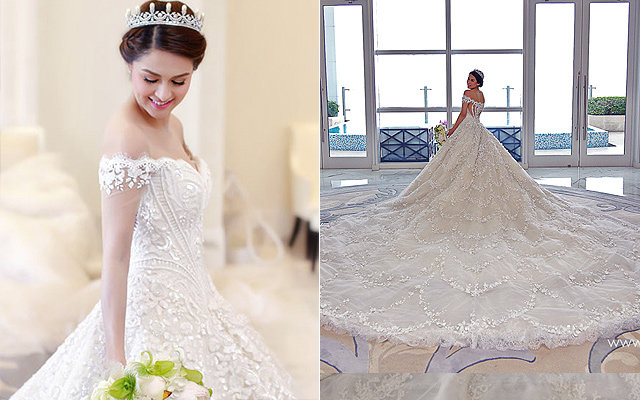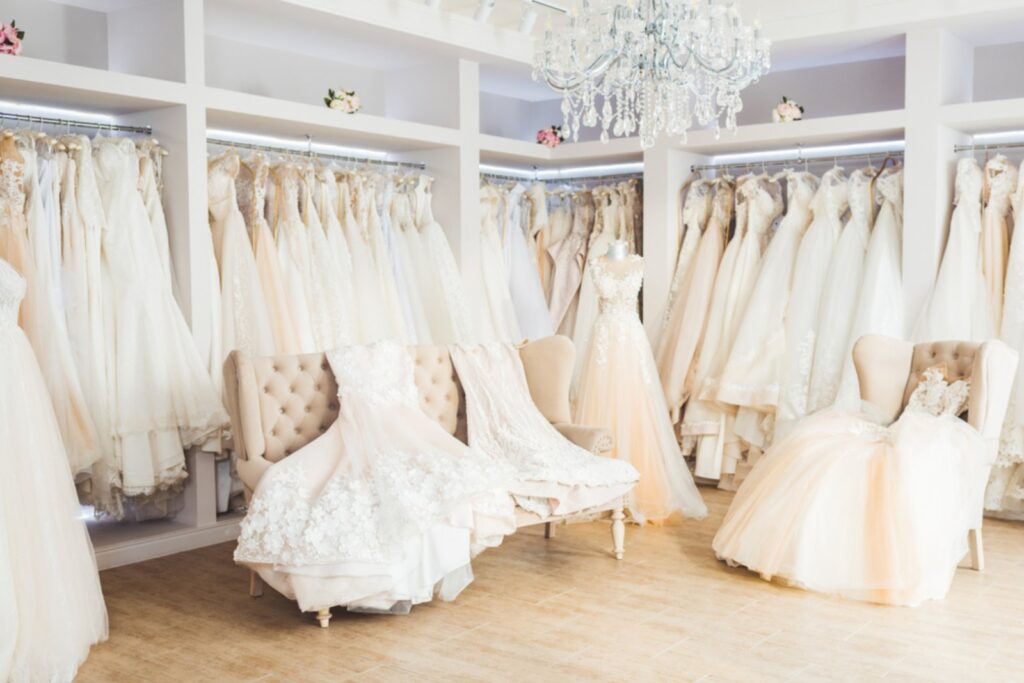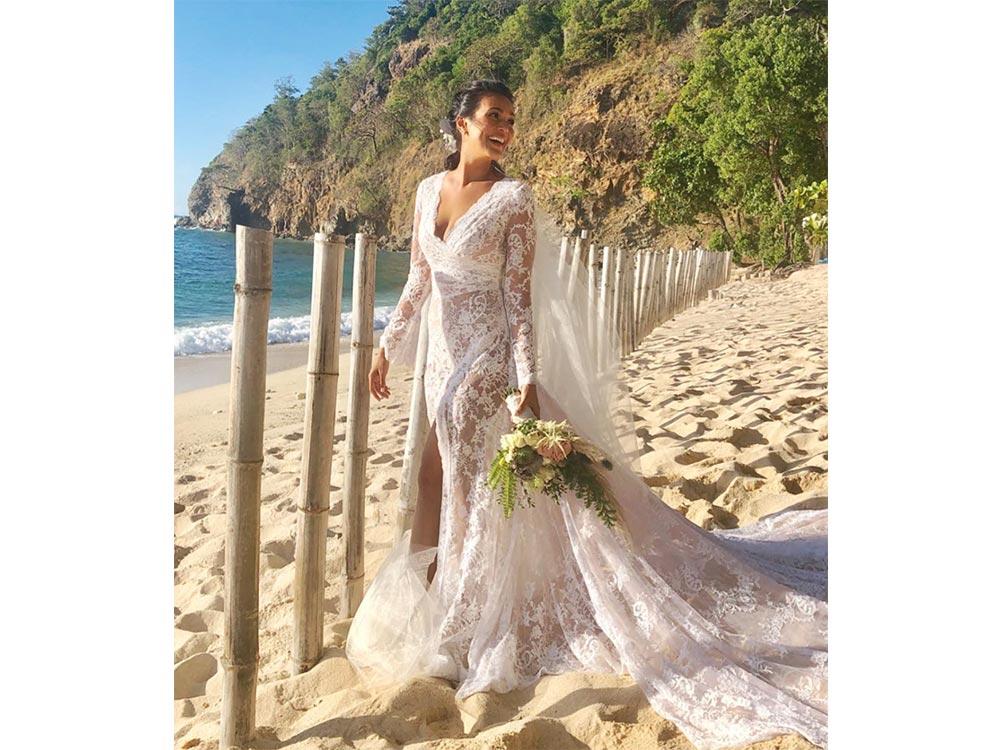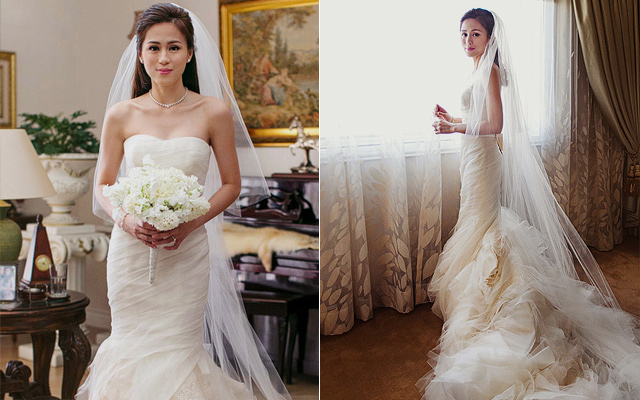SHOPPING for your dream wedding gown can be wonderfully exciting yet overwhelming and confusing. In this fast-paced life where we have the entire world digitally at our fingertips, all you need to do is google “bridal outfit” and your feed is inundated with a multitude of images.
There are many designs and sources to choose from. While some brides invest in a couture gown, others opt to go to a boutique to find the perfect off-the-rack (OTR) wedding dress. Aside from being cost-effective, both options are appealing to shoppers.
What is a couture wedding gown?

It is a one-of-a-kind, made-to-measure dress of an original design made out of the highest quality materials. It’s made completely from scratch for each individual bride.
What is an OTR bridal attire? Sometimes called pret-a-porter, ready-to-wear (RTW), or ready-made, this outfit is manufactured and often mass-produced in a selected standardized size range.
If you’d like to know the key differences between these options and which one would best suit your needs and preferences, here are some points you may have to consider.
Budget
In general, OTR costs less compared with other options. It’s because you’ll be getting the dress as it is, without customization or alterations. However, it’s also possible to make minor adjustments to the dress as needed with additional costs. As such, if you are looking for a budget-friendly alternative, then shopping for RTW is ideal for you.
On the other hand, couture gowns may cost you more. To get a made-to-measure dress, you’ll need to pick from the collection of pre-made designs in the shop. Then, they’ll take your measurements and create a dress accordingly. Because of the time, effort, and resources needed in creating a custom-fit gown, you’ll need to prepare a bigger budget for it.

Planning and preparation
For those working with a tight timeline for the nuptials, finding the perfect OTR dress will be your best option. Once you find your dream gown, you can take it home right away and wear it as it is on your wedding day.
Meanwhile, a made-to-wear dress is an excellent choice for those who prefer to make preparations ahead of schedule. Usually, creating a customized wedding gown takes three to six months. Though it may take longer than OTR, the payoff would be worth the wait as you’re guaranteed a perfectly-fitted dress suited to your size. You’ll also have enough time to make adjustments where needed.
Style preferences
Both OTR and couture gowns have pre-made designs you can choose from. If you have specific cut, style and design preferences, both choices will make it easy to find a dress that would suit your taste. However, there are also limitations regarding design availability, particularly in the OTR option.
For instance, you may find a dress with a good design but is poorly fit. In this case, made-to-measure gowns can give you more flexibility because you’re guaranteed an outfit in your exact size with the design that you selected. Also, you can make minor adjustments to your custom-made gown according to your preferences.
Comfort
Since OTR dresses come as they are, you’ll have to pick one that gives you the most comfort. You should be able to move with ease as you wear it, and the fabric must also feel comfortable against your skin. Furthermore, you may need one made of breathable and absorbent material to protect you against sweat.
Made-to-measure dresses, though pre-designed, are more flexible when it comes to fabrics. Since it’s custom-made, you can ask the shop to use the textile of your choice or recommend alternatives that would make you feel more comfortable and at ease on your big day. To help them make suggestions, you can specify the time, date, and wedding venue. This information can help them pick a material that would suit the climate and location.
Aside from this, you may also need to inform them if your skin is sensitive against certain types of cloth or if you’re prone to rashes and irritation. This way, they can take this into account as they create your gown.
Design differences

OTR and RTW gowns come in an array of styles and designs. As these styles are mass-produced, it is a “what you see is what you get” kind of scenario.
Typically, changes to the design are not an option in the production of the gown. If a bride wants to change the style or design of the dress, this is done during alterations. More often than not, when these additions or changes are made, it is apparent that they were not a part of the original design.
Many couture bridal designers work with each bride to create an entirely unique gown just for her.
Removable sections
With couture design, there is a high capability to create many looks within one garment. Should you want to be more modestly covered for a church ceremony and showing more skin for the reception, pieces of your gown that fit and look cohesive but are also removable can be made.
Gown sizing, fit and alterations
RTW gowns are purchased either online or at a bridal salon. To order, you will need to be measured, then they will compare your measurements to the size chart. Whichever size your largest measurement (hips, bust or waist) falls under is what you will need to order.
It’s important to note that the standardized size guide for bridal wear is very different from everyday casual clothing. You may wear a 4 in jeans, but according to the size guide, you could be an 8 in a bridal outfit.
An OTR will require alterations to fit properly. Whether it be taking in or letting out the waistline, adjusting the hem, adding boning or lengthening the straps, alterations are a necessity to ensure a proper fit on your wedding day.
Be aware that there is simply only so much that can be done to a gown when getting it altered. Every time a gown is taken apart at a seam, the fabric loses some of its structural integrity.
When gowns are manufactured and mass-produced, they are cut with minimal seam allowance. The seam allowance is the extra fabric at the edge of a garment pattern piece for the creation of a seam or hem. With just a minimal seam allowance, if a gown needs to be let out in any way, there can be merely 1 cm of wiggle room.

If a gown needs to be taken in, the fabric will likely need to be cut away, and should it be a major adjustment, this can alter the intended design of the gown. This is particularly of note in gowns that have patterns or motifs on them.
It is imperative that when your OTR requires alterations you seek the best alteration professional. A dress that is improperly altered will be apparent in the fit and finish of the gown.
On the other hand, since a couture gown is made specifically for you and your exact body measurements, no alterations of any kind are required.
Fit is an absolute guarantee with a couture gown. You will be able to do exactly what you want to on your wedding day. Whether it be dancing around in a strapless gown or sitting down and eating that delicious wedding meal in a mermaid style, a couture gown will be functional in every way without hindering you in the enjoyment of your day.
The fit of a couture gown feels unlike anything you can buy in a store. The beauty of a couture wedding dress is that you’ll get a fit that is both flattering and unique to your specific body just the way it is.
Quality of fabrics

Typically, RTW comes in a narrow number of fabric configurations. While there are some color and textile choices, brides are limited to the more traditionally accepted options such as white, off-white or ivory, champagne and blush. Usually, these options are used across the collection, and there will be a number of brides with the exact same combinations.
The majority of OTR brands use synthetic materials such as polyester and nylon for their gowns. Synthetic fibers such as these are not moisture-wicking, and can also produce an unappealing odor when perspired in.
Another item of note is that when photographing a true white gown, it tends to appear blue in photos. This is because pure white is not a naturally occurring color on the spectrum, and thus can not be a natural fiber such as silk.
Yes, higher-quality fabrics such as silks are more expensive than synthetics, but when you wear high-quality textiles, they look, move, feel and photograph unlike anything else. When wearing a luxury cloth such as silk, it will feel like you’re wearing a cloud as it is so incredibly lightweight and sensuous to wear.
Construction

Most RTW gowns are manufactured in a factory. In the process, these gowns are cut and sewn by machine, using as few seams and pieces as possible.
This is done to cut down on costs and can often affect the end product from fitting correctly. Think about an Art Deco style pattern, for example. If not properly placed upon the body, the contour essentially can draw a line pointing right to an area that a woman may not want attention drawn to.
Additionally in the construction of an RTW, the underpinnings (foundation) of the gown are not necessarily done with the highest quality of materials.
Price differences
While shopping OTR can effectively stretch your budget, it does come with its own caveats. The benefit of made-to-order dresses is that payments can be spread out over time. That’s a perk you’ll have to forfeit for the luxury of being able to take your dream gown home with you that same day. Purchasing an OTR outfit means you’ll have to pay the full price upfront. Be sure to understand the store’s return policy as well. Often, these clothes are final sale so there’s no wiggle room for buyer’s remorse.
When purchasing an OTR, there are additional factors to consider when looking at the sticker price. There are typical alterations above and beyond the cost of the dress. These would include hemming, taking in or letting the bodice out, adding a bustle, etc.
Prices are based on industry standards and could fluctuate based on body type, style of dress and fabric used.
Should you choose to change the design of the gown, the alteration cost will increase. By adding sleeves, for example, you would need to factor in the purchase prices of the material as well as the cost to fabricate and add the sleeve to your gown, as well as other incidentals.
It is impossible to say exactly what a couture gown will cost without first having a consultation. Its cost is determined by your prescribed budget. The designer works with the bride’s style inspiration to create an outfit that works for her and the desired price point.
RTW brands and stores
In recent years, the demand for OTR wedding gowns has boomed, especially with the pandemic lockdowns and the limited opportunities for dress fittings and canvassing. With this rising interest in RTW, many boutiques and fashion designers in the Philippines have now started to go online, which may make your decision a bit easier.
If you’re on the hunt for the perfect outfit, here are a few brands and stores you can check out to narrow down your search: Karimadon; Apartment Eight (Apartment8Clothing.com and Instagram); I Do by Zoo; Love, C (Instagram); Cou Cou by Mel Orlina; Bella Borromeo Atelier (BellaBorromeoAtelier.com and Instagram); White Label Bridal; Bride and Rose (BrideandRose.com and Instagram); Bridal Boutique Manila (BridalBoutiquePh.com); The Bridal Room (Instagram at The Bridal Room PH and email the bridalroomph@gmail.com).
For alterations, try Alter to Fit (AlterToFit.com) and Alterations Plus.
Should you spend a lot on your wedding attire? The cost of your dress would entirely be dependent on you, with some brides choosing the designer route and some picking out gowns that are more practical. Something to remember though – selecting the more practical route doesn’t mean that you’re settling for something less. There are hundreds of choices you can go for at different price points, which means that you can get a dress with the same style you’ve always dreamed of but with a more friendly price tag.
What’s important is that you choose an outfit based on your comfort and style, be it a tailored one or a more affordable OTR. Whatever bridal wear you pick, go for the one you’re most comfortable with, especially since you’re probably going to wear it until the reception. You want your nuptials to be unforgettable for all the good reasons, not memorable because of how unbearable your dress or shoes were.





